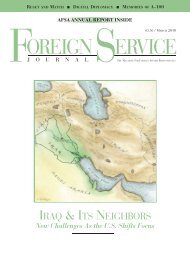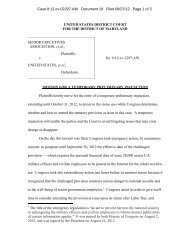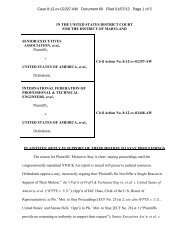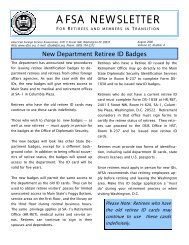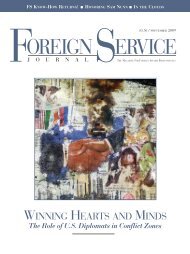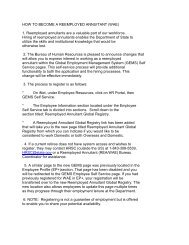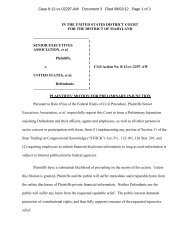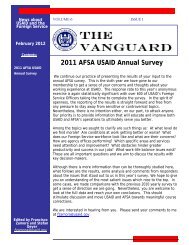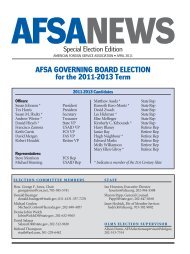F OCUS - American Foreign Service Association
F OCUS - American Foreign Service Association
F OCUS - American Foreign Service Association
Create successful ePaper yourself
Turn your PDF publications into a flip-book with our unique Google optimized e-Paper software.
They may also not expect changes in<br />
themselves after living and working<br />
overseas. Further, families and friends<br />
generally do not expect the travelers to<br />
have changed, and may show little interest<br />
in the overseas experiences of<br />
those returning. Returnees are thus<br />
set up for a clash between expectations<br />
— their own and others’ — and experience.<br />
Repatriation has come to be understood<br />
as the return of “a stranger to a<br />
strange land.” The result can be varying<br />
degrees of feeling lost or not fitting<br />
in, short- or long-term loneliness, isolation<br />
and even depression. This can<br />
affect not only the emotional wellbeing<br />
of the individual, but also the<br />
family. According to social work’s family<br />
systems thinking, which views the<br />
family as a dynamic interacting unit,<br />
what affects one member affects the<br />
other members as well. As such, reentry<br />
symptoms in the spouse can affect<br />
everyone in the family unit and<br />
their interactions at home, as well as at<br />
school and in the workplace.<br />
I learned about this issue the hard<br />
way. My first re-entry, with a 3-yearold<br />
child and another on the way, was<br />
the most difficult. In fact, a stress test<br />
taken at the time put me, the test administrator<br />
said, “way over the top.”<br />
The second return was not as hard for<br />
me personally, but my middle-school<br />
sons were “way over the top” trying to<br />
fit in. The third time, with children in<br />
late high school and early college, was<br />
the easiest for the entire family.<br />
Repatriation has come<br />
to be understood as the<br />
return of “a stranger<br />
to a strange land.”<br />
Experience-Based Research<br />
These experiences motivated my<br />
choice of re-entry as a thesis topic<br />
while I was a student at the Smith College<br />
School for Social Work. I wanted<br />
a better understanding of the conditions<br />
and the factors that influence the<br />
readjustment of spouses.<br />
My proposal to the Associates of the<br />
<strong>American</strong> <strong>Foreign</strong> <strong>Service</strong> Worldwide<br />
to conduct a study among its membership<br />
was approved by the board of directors.<br />
(I did not seek a sample within<br />
the State Department due to the<br />
lengthy and uncertain approval process<br />
involved.) The 10-page questionnaire<br />
I sent to 580 active AAFSW members,<br />
including all <strong>Foreign</strong> <strong>Service</strong> spouses<br />
who were not current U.S. government<br />
employees, produced a 158-person<br />
sample, more than adequate for<br />
meaningful statistical analysis of the results.<br />
I chose four areas of exploration:<br />
demographics, characteristics of the<br />
spouses’ last overseas assignments and<br />
last re-entries, and any changes in their<br />
cultural (<strong>American</strong>) identity after living<br />
overseas. My aim was to identify<br />
factors in each of these areas associated<br />
with spousal re-entry adjustments so as<br />
to be able to provide preventive information<br />
useful to spouses and those<br />
working with them overseas and at<br />
home.<br />
The data analysis had two parts.<br />
The first was descriptive in nature, providing<br />
demographic, overseas and reentry<br />
information about the sample.<br />
The second part, measured by the<br />
Homecomer Culture Shock Scale designed<br />
in 1988 by Jeffrey Fray of the<br />
University of Tennessee, looked for relationships<br />
between factors and each<br />
spouse’s re-entry adjustment. Both<br />
parts could provide valuable information<br />
for the continuing development of<br />
programs to address the needs of FS<br />
spouses. A third set of results consisted<br />
of the spouses’ own short-answer reflections<br />
on their last experience.<br />
Study Results<br />
The descriptive results provide an<br />
interesting overview of a group of <strong>Foreign</strong><br />
<strong>Service</strong> spouses who are not normally<br />
tracked by the State Department<br />
due to privacy concerns. Though certainly<br />
older, on average, than the<br />
spouses of active-duty FSOs, the sample<br />
accurately reflected the range of experience<br />
of accompanying spouses.<br />
Seventeen percent were foreign-born<br />
and another 9 percent were U.S. citizens<br />
raised internationally. Eighty-six<br />
percent had a college education or<br />
higher; of these, nearly 44 percent had<br />
postgraduate degrees.<br />
As a group, they were married to an<br />
FSO for an average of 26 years and had<br />
2.32 children per spouse, nearly the<br />
same as the U.S. national average. At<br />
the time of the study, 40 percent were<br />
working full-time, 30 percent were volunteering,<br />
20 percent were working<br />
part-time and volunteering, and 10<br />
percent were retired. Most spouses<br />
appeared content with their last overseas<br />
assignment and reported that<br />
their participation in activities had<br />
been high (though their interaction<br />
with embassy personnel and formation<br />
of friendships within the U.S. embassy<br />
community were both low).<br />
More than half were employed at<br />
least part-time at their last assignment;<br />
of those, more than three-quarters<br />
were completely or mostly satisfied<br />
with their work. Eighty percent had<br />
volunteered at their last overseas post<br />
and reported high satisfaction with that<br />
work — an indication that the Family<br />
Liaison Office initiative to extend employment<br />
and volunteer opportunities<br />
for spouses overseas is working.<br />
At the time of their last re-entry,<br />
most spouses (80 percent) had had<br />
previous returns, while for 20 percent<br />
it was their first experience. More than<br />
50 percent had been back for more<br />
than 10 years, while 25 percent had<br />
been back for three years or less. Onehalf<br />
had young children and adolescents<br />
at the time of re-entry, and the<br />
34 F O R E I G N S E R V I C E J O U R N A L / A P R I L 2 0 0 9



